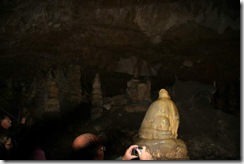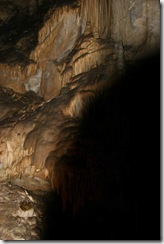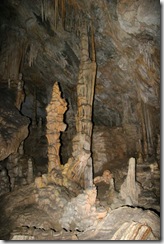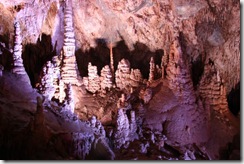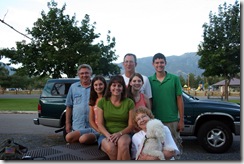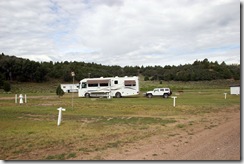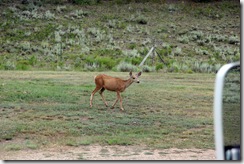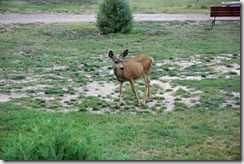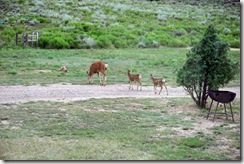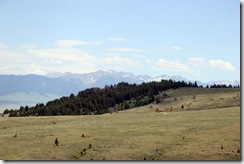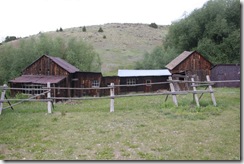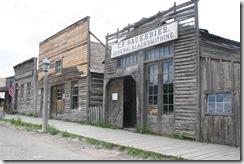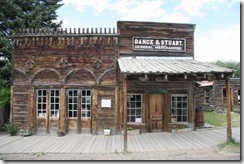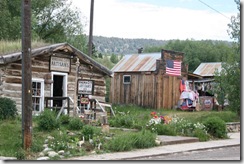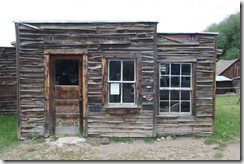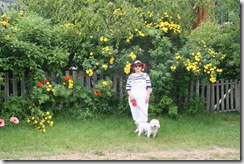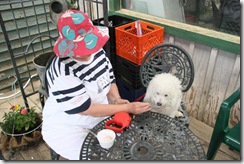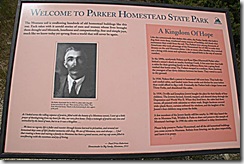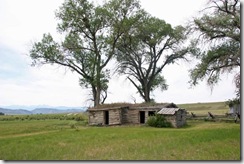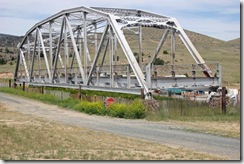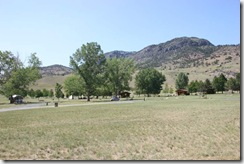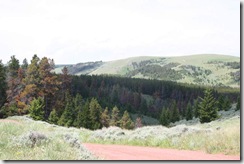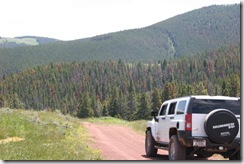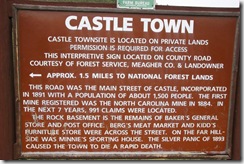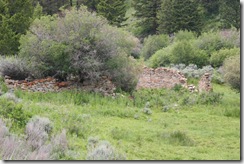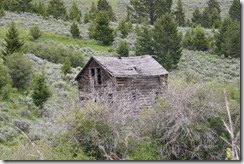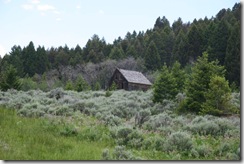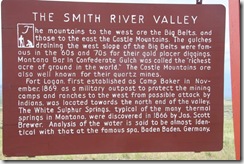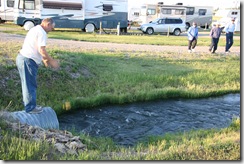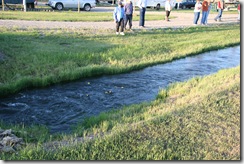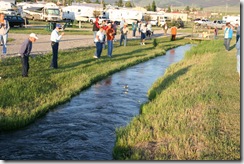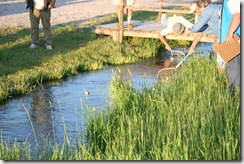Well when you can get no one else to the job, one must do it himself so Pop baked his own Huckleberry pie this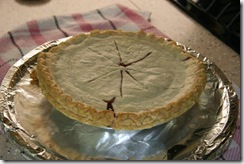 morning.
morning.
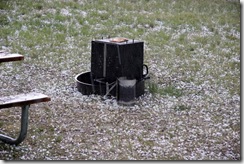 The pie went well with the BBQ pork chops that Pop cooked this evening in a Montana snow. Even Mik enjoyed the pie and especially the whipped cream from the magic can. It was Mik’s reward for having to stay in the coach while we toured the Lewis and Clark Caverns in the afternoon.
The pie went well with the BBQ pork chops that Pop cooked this evening in a Montana snow. Even Mik enjoyed the pie and especially the whipped cream from the magic can. It was Mik’s reward for having to stay in the coach while we toured the Lewis and Clark Caverns in the afternoon.
Wonderground
 The marvels of Lewis and Clark Caverns State Park. By Scott McMillion
The marvels of Lewis and Clark Caverns State Park. By Scott McMillion
This story is featured in Montana Outdoors
July–August 2004
This is a story shaped by water in all its forms: tiny drops and rushing torrents and rising vapors, rainstorms that slicken hillsides and droughts that crack them open, gullywashers that uproot trees and ice that can crack a stone. It’s about the greatest of floods, and it’s about the warm mist of your breath.
At Lewis and Clark Caverns State Park, whether you’re underground or above it, the world around you is shaped by water.
Water sculpted the famous caves, drop by patient drop, hauling microscopic bits of stone from one place to another. And it was water, appearing as steam from the ground one cold day, that originally brought white men here.
Tom Williams and Bert Pannell first peered into the caverns on a winter day in 1892. They’d been hunting and saw what looked like a column of smoke rising from a hillside. They labored up the mountain to investigate and learned that it wasn’t smoke at all: It was steam, the steady exhalation of living, breathing caves. The warm air was pushed from the mountain’s lungs only to become ice in the cold air, transformed into crystals so tiny they floated skyward and evaporated in the sun.
American Indians had seen this “smoke,” this breath from a mountain, or at least that’s the way the story goes in the farms and towns around the caverns. But nobody knows for certain. If the Blackfeet or Shoshone or anybody else had explored these caverns, they left behind no sign.
Perhaps, like Williams and Pannell, they dropped a stone down the steaming shaft, listened to its echoes, and vowed to come back. It took Williams six years to return to what he called the “hole in the rock,” bringing friends and ropes and candles to see just what existed below.
And what a day they must have had. It was 1898, long before movies or color photographs. Perhaps the illustrated magazines of the day had sparked their imagination with renderings of famous caverns in other parts of the world. Maybe they had some notion of stalactites and stalagmites and the way water works with limestone to make stone waterfalls, columns, and wedding cakes. Or maybe they didn’t. Maybe everything lit by their sputtering candles was a brand-new vision, a finding as exotic as a mammoth tusk. But surely those who first peered into the caves’ depths must have been stupefied by the foreign, unimaginable world before them. Some were likely scared half to death.
And then the American entrepreneurial spirit kicked in. These caves were fascinating. Surely people would pay to see them. But how to attract them to the site? That’s where Dan Morrison came in. A successful prospector, Morrison was a man who knew how to work underground, always on the lookout for a new way to turn a dollar. Williams approached the prosperous miner, led him into the caverns, and asked what he thought. Morrison saw dollar signs reflecting from the glossy surfaces.
He’d made money before in the hills where the great caverns were formed. His lime quarry, along with three nearby gypsum mines, supported the lively community of Lime Spur. Morrison already had some claims in the hills and, figuring the caverns were on public land, filed a claim on that area, too.
Next he went to work improving his new property, building a trail to the caverns, widening a second entrance, and installing 2,000 wooden steps to carry paying customers in and out of the caves. He advertised, and news quickly spread of the beautiful caverns overlooking the Jefferson River.
That’s when the Northern Pacific Railroad became interested in the caves. One of the most powerful interests in Montana, the railroad threw its considerable legal and political weight behind its contention that the increasingly famous caverns were its property, not the mining claim of some local impresario.
The debate soon landed in the courts, which ruled in favor of the railroad. What Northern Pacific then did with its newly cleared title and accompanying marvels surprised everyone. In 1908, after years of flexing its legal muscle in the courts to exert its property rights, the railroad gave the caverns to the federal government.
President Theodore Roosevelt, one of the nation’s great conservationists and the kind of guy who likely would have 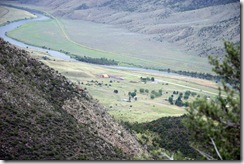 enjoyed spelunking the caverns, selected a name for the newly obtained property: Lewis and Clark Caverns. The famous explorers had never actually visited the site, but they had hiked near the caverns on Cave Mountain in 1805 looking for Shoshone Indians, and a portion of their famous route was visible from the caverns’ entrance.
enjoyed spelunking the caverns, selected a name for the newly obtained property: Lewis and Clark Caverns. The famous explorers had never actually visited the site, but they had hiked near the caverns on Cave Mountain in 1805 looking for Shoshone Indians, and a portion of their famous route was visible from the caverns’ entrance.
The government designated the newly named caverns the nation’s 12th national monument—then slapped a lock on a barricade and ordered everybody to stay the heck out. Morrison ignored the dictate. He broke the first lock and brought in tours. Whenever the government installed a new lock, he broke it, maintaining a condition of perpetual defiance until his death, in 1932, at the age of 80.
Around that time, the federal government was wondering what to do with the caverns. National Park officials knew the site was too fascinating to be locked away, but after a quarter-century they still hadn’t figured out a way to open the gates. Meanwhile, Montana was looking for a state park. It had formed a state parks program in 1929 but had yet to acquire a site. The match was obvious.
Before handing the caverns over to Montana, however, the federal government agreed to make improvements. The work began in 1935 with the arrival of the Civilian Conservation Corps, a federal public works program that set up camp at LaHood, just a few miles up the Jefferson from the caverns. The industrious CCC crews turned the caverns into what visitors see today. They built roads and a visitor center, widened passages, and chiseled steps into limestone. They laid electric cable to power a new system of lights. And they hauled out tons of bat guano. They also explored the caverns more fully, discovering the remarkable Paradise Room, where they blasted a 538-foot exit tunnel so visitors could make a one-way tour of the caverns and not have to climb the long stairs back to the entrance.
After World War II, the state began its own improvements, such as tearing down Morrison’s wooden steps, including a rickety spiral staircase that yawed as much as 2 feet while suspending visitors over a 90-foot drop. A short railroad was built from the visitor’s center to the caverns, where tourists then took a tram car up the last several hundred feet of nearly vertical ascent, its clacking and groaning adding to the excitement of seeing the caves.
By the early 1970s, the train and tram were deemed unsafe and removed. Today, all visitors must take a short hike to reach the cave entrance, where the guided tours begin. It’s understandable that most people are in a hurry to see the caverns. But it’s best not to rush. The walk up a moderately steep path to the cave mouth is a fascinating journey in its own right.
Check out some of the boulders and exposed rock faces for fossilized shellfish, evidence of how this layer of 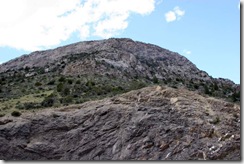 mountain was made. Roughly 330 million years ago, much of Montana lay beneath a shallow sea. Runoff carried dissolved minerals to the sea bottom, where the growing layers of silt would eventually become limestone. Then, pressures from deep within the earth started lifting layers of rock, pushing older rock through the limestone, kneading the surface of the earth like bread dough, leaving cracks and fissures and holes.
mountain was made. Roughly 330 million years ago, much of Montana lay beneath a shallow sea. Runoff carried dissolved minerals to the sea bottom, where the growing layers of silt would eventually become limestone. Then, pressures from deep within the earth started lifting layers of rock, pushing older rock through the limestone, kneading the surface of the earth like bread dough, leaving cracks and fissures and holes.
Much later, water teamed with gravity and chemistry to eat away the limestone, moving it forever downhill by drops and trickles, patiently undoing the hasty work accomplished by volcanic uplifts hundreds of millions of years before. That process made the caverns and shaped the hillsides above them and the river valley below.
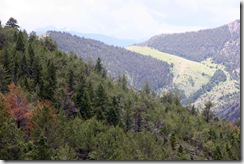 As you climb, how everything changes. The vegetation grows greener, the soil turns dark, and the signs of wildlife become more abundant. The trail ends at the park’s upper picnic area, a forested glen beside a tiny stream that’s handy for eating a midday meal or letting the kids chase water bugs while you take a nap amid the birdsong.
As you climb, how everything changes. The vegetation grows greener, the soil turns dark, and the signs of wildlife become more abundant. The trail ends at the park’s upper picnic area, a forested glen beside a tiny stream that’s handy for eating a midday meal or letting the kids chase water bugs while you take a nap amid the birdsong.
Inside the caverns

